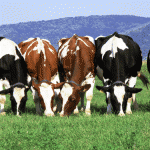
These glasses contain the same amount of liquid. Image: Boule/Shutterstock
Have you ever finished a drink almost twice as fast as your friends?
You are out for a drink with some friends and you all order is a beer. You get a slightly different shape of glass to everyone else — curved instead of straight — but it doesn’t matter, it’s still the same amount. But as you sit chatting and drinking, you notice that you keep finishing your beer first — your friends are almost twice as slow as you.
This doesn’t necessarily mean you’re thirstier than them or more likely to be an alcoholic; the shape of your glass could be playing tricks with your mind. Dr Angela Attwood from Bristol University, UK, and her colleagues suggest that this may be because it is more difficult to gauge the halfway point in these shaped glasses.
Without this marker, it may be hard to judge just how much you have consumed. “People often talk of ‘pacing themselves’ when drinking alcohol as a means of controlling levels of drunkenness, and I think the important point to take from our research is that the ability to pace effectively may be compromised when drinking from certain types of glasses,” Attwood says.
To test this theory, she and her colleagues recruited 160 social drinkers, aged 18-40 and with no history of alcoholism, to attend two experimental sessions. In the first, they were given glasses of larger or a non-alcoholic soft drink, served from either a straight or a curved beer glass. Those drinking from a curved glass finished their drinks nearly twice as fast as the participants drinking the alcohol from a straight glass. There was, however, no difference in soft drink consumption rates.
In the second test, the participants were asked to look at images of the two types of glasses with varying volumes of liquid and asked whether they thought they were more or less than half full. The results, published in the journal Plos One, showed that there was a greater degree of error when it came to judging levels in the curved glasses.
This degree of error was also associated with drinking speed — the volunteers who had more trouble judging the amounts in the glasses also had the greatest changes in drinking rates. And as we know, the speed at which you drink influences how many beers (or any other alcohol, for that matter) you consume.
“Due to the personal and societal harms associated with heavy bouts of drinking, there has been a lot of recent interest in alcohol control strategies,” Attwood says. “While many people drink alcohol responsibly, it is not difficult to have ‘one too many’ and become intoxicated.”
Source: Bristol University






